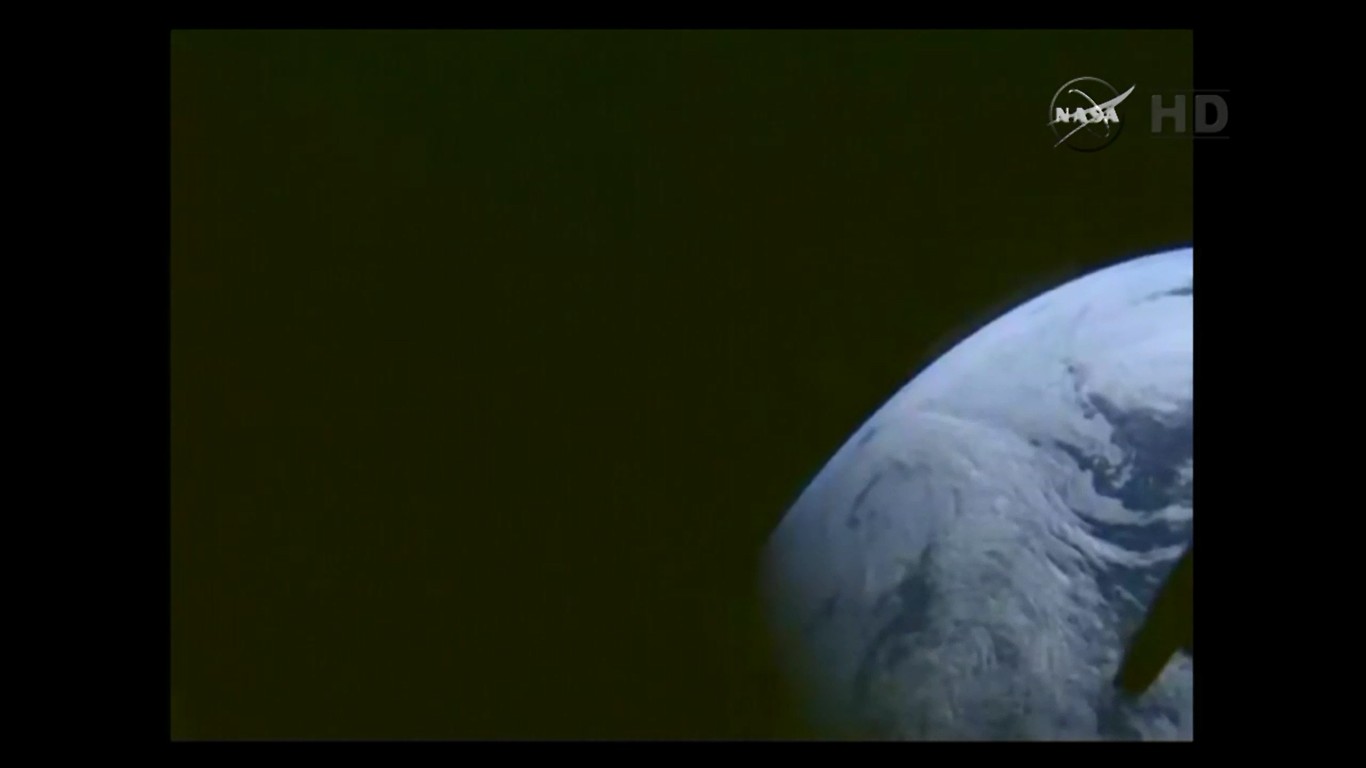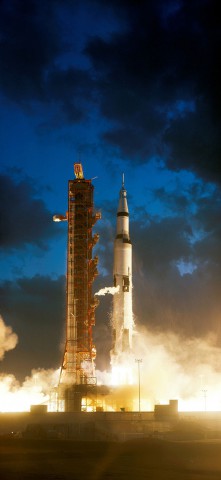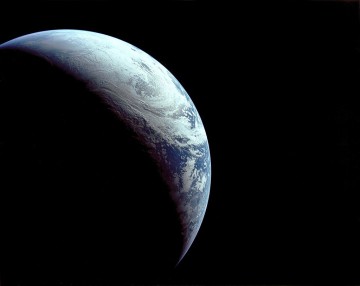
Yesterday, a machine designed to carry humans beyond low-Earth orbit for the first time in more than four decades came screaming back through the atmosphere at more than 20,000 mph (32,000 km/h) and temperatures in excess of 2,200 degrees Celsius (4,000 degrees Fahrenheit), headed for a smooth, parachute-assisted splashdown in the Pacific Ocean. NASA’s Orion spacecraft—flying its long-awaited Exploration Flight Test (EFT)-1, atop a Delta IV Heavy booster—was delivered to a peak apogee of 3,600 miles (5,800 km), more than 15 times higher than the orbit of the International Space Station (ISS). This made it the farthest human-rated spacecraft since the end of the Apollo era. Almost half a century since NASA first sent astronauts beyond low-Earth orbit, Orion’s myriad systems were evaluated during a perilous passage through the harsh radiation environment of the Lower Van Allen Belt, and its ability to survive re-entry velocities close to what it would experience during a return from lunar distance was tested in the most rigorous manner possible.
Yet the fanfare associated with the mission—and the undeniably remarkable success of EFT-1—does not detract from the reality that NASA has a long way to go before it can hope to replicate the kind of deep-space piloted missions that it staged over a four-year period between Apollo 8 in December 1968 and Apollo 17 in December 1972. During that bygone era, no fewer than nine teams of astronauts returned from the Moon at velocities as high as 25,000 mph (40,230 km/h), and their hardy Apollo command modules, so similar in physical appearance to the conical Crew Module of today’s Orion, endured peak re-entry temperatures of 2,760 degrees Celsius (5,000 degrees Fahrenheit).
In some respects, EFT-1’s accomplishment is reminiscent of the unmanned Apollo 4 mission on 9 November 1967, which rode the maiden voyage of the mighty Saturn V. Yet in other ways, Apollo 4 accomplished far more on its 8.5-hour flight than did Orion on its own mission, 47 years later. The spacecraft was delivered into a “parking orbit” of 115 miles (185 km), after which it executed two orbits of Earth, before the Saturn’s S-IVB third stage ignited for a second time to increase its apogee to 10,700 miles (17,220 km). Next, the Service Propulsion System (SPS) engine aboard Apollo 4’s service module was fired to send the spacecraft to a distance of 11,240 miles (18,090 km), whereupon it endured a 4.5-hour “soak” in the little-known radiation and temperature environment of deep space, between the inner and outer Van Allen Belts. In doing so, Apollo 4 dipped its toe into the kind of conditions that astronauts would soon experience as they journeyed across the 240,000-mile (370,000 km) gulf to reach the Moon.

Aboard the spacecraft was an automatic film camera, which—in a similar vein to Orion’s EFT-1 mission—successfully acquired imagery of almost the entire Home Planet. For more than two hours, as Apollo 4 neared and passed its point of apogee, the camera recorded 755 color images at altitudes between 8,400 miles (13,510 km) and 11,240 miles (18,090 km). At length, with the nose of the conical command module pointed Earthward, Apollo 4’s SPS engine fired a second time for 281 seconds to bring it home. The service module separated, as planned, and the command module hit the upper atmosphere at a flight path angle of 7.077 degrees and a velocity of 24,920 mph (40,100 km/h) to simulate a return from lunar distance. Eight and a half hours after launch, the scorched and blackened command module descended to a splashdown in the north Pacific Ocean, just to the northwest of Midway Island. “The thermal conditions would equal the worst case possible during a return from the Moon,” wrote Chris Kraft in his autobiography, Flight. “It could hardly have been better. The command module’s guidance system controlled it through some complex entry maneuvers, its heat shield gave it more than enough protection, its parachutes opened and it splashed down less than ten miles (16 km) from our aiming point.” Seamen aboard the USS Bennington, the prime recovery ship, watched as Apollo 4 neared the ocean, beneath its three perfect parachutes, just as the crew of the USS Anchorage did for Orion, a few short days ago. And like the post-landing operations of EFT-1, the recovery of the spacecraft was accomplished by the combined efforts of an enormous NASA-Navy team, incorporating helicopters, boats, and hundreds of personnel.
When one peruses the numbers, it is apparent that Apollo 4 traveled almost half a century ago to a far higher apogee, executed independent maneuvers with its main propulsion system, re-entered the atmosphere at far higher velocity, experienced far higher surface heating, and rode atop a far more powerful booster than Orion did on Friday, 5 December 2014. This, in a sense, is disappointing. On the other hand, Orion—it is hoped—will provide a broader base and a wider range of capabilities in the longer term for piloted deep-space exploration to a variety of celestial destinations. Moreover, in the late 1960s, Apollo was not undertaking its historic voyages in tandem with a permanently occupied space station and a viable Commercial Crew capability.
At one stage, NASA planned to launch a crewed Apollo mission to a similar altitude as EFT-1. The original line-up for America’s drive to land a man on the Moon by the end of the 1960s envisaged a seven-step process, labeled “A” through “G.” First came unmanned test flights (“A”) of the Apollo command and service modules (CSM), followed by an unmanned shakedown (“B”) of the spider-like lunar module (LM). A piloted “C” flight of the CSM in Earth orbit would then be followed by a manned demonstration of the entire CSM/LM system (“D”) in Earth orbit, after which the missions would become increasingly more complex, with a full dress rehearsal in lunar orbit (“F”) and the long-awaited first landing of humans on the surface of another world (“G”). Each of these crewed flights actually happened: Apollo 7 in October 1968 flew the “C” mission, Apollo 9 in March 1969 undertook the “D” mission, Apollo 10 in May 1969 executed the “F” mission, and Apollo 11 in July 1969 triumphantly planted the Stars and Stripes into lunar soil on the historic “G” mission. Yet one voyage which did not take place was the now largely forgotten “E” mission, originally baselined as a high-apogee test of the CSM/LM combo, which was tasked with flying to a record-setting altitude of more than 4,000 miles (6,400 km). This would soundly surpass the previous record of 850 miles (1,370 km), reached by Gemini XI astronauts Charles “Pete” Conrad and Dick Gordon in September 1966.
Initially, veteran astronauts Frank Borman, Tom Stafford, and Mike Collins were named to the “E” mission, originally designated “Apollo 3” and scheduled to launch sometime in the summer of 1967. However, as recounted by Deke Slayton in his autobiography, Deke, the crew plan was adjusted in short order. “It wasn’t absolutely necessary for [Borman] to have two experienced guys with him,” Slayton wrote, “so I moved Tom Stafford off Frank’s crew.” Consequently, another astronaut, Bill Anders, joined the crew as its third member. Their backups were Neil Armstrong—who later became the first man to set foot on the Moon—together with Buzz Aldrin and Fred Haise. In addition to their high apogee, the E crew would become the first humans to ride the behemoth Saturn V, and this caused their mission to become known internally as “Apollo-Saturn 503” (AS-503).

In a fashion not dissimilar to the maneuver planned on Moon-bound Apollo missions, it was intended that the Saturn V’s S-IVB third stage would be ignited a second time, though not for a Trans-Lunar Injection (TLI) “burn,” but instead for a shorter firing to deliver Apollo 3 into a lopsided orbit, with an apogee that extended one-sixtieth of the distance to the Moon. Although an infinitesimally small leap into the cislunar gulf, it would nevertheless represent the farthest distance that humans had ever traveled from the Home Planet. The mission was expected to last “up to 11 days.” However, the highly elliptical orbit posed its own set of issues. “This little detail created all sorts of planning problems,” Collins explained in his autobiography, Carrying the Fire, “because one could only escape from this lopsided orbit at certain prescribed intervals and if one had troubles and was forced to return to Earth prematurely, it was entirely possible to end up landing in Red China. Following our high-altitude stint, we would give our LM a workout, conducting an elaborate rendezvous sequence.”
The tragic loss of the Apollo 1 crew in January 1967 brought the program to its knees, but the year ended with the triumphant maiden flight of the Saturn V and a wave of optimism that the lunar landing could be accomplished before the end of the decade. From April 1968, some NASA managers began talking actively about eliminating the E mission entirely and expediting Borman’s crew from high Earth orbit to a circumnavigation of the Moon. An already record-breaking apogee of 4,000 miles (6,400 km) would be multiplied sixtyfold to 240,000 miles (370,000 km). As circumstances transpired, poor Mike Collins was removed from the crew for medical reasons in July, and Borman, Anders, and Jim Lovell would end up flying Apollo 8 on humanity’s first voyage to lunar orbit in December 1968. Had the story turned out differently, the Apollo “E” mission would have virtually mirrored the flight profile of Orion’s EFT-1, albeit with astronauts aboard.
Although the E mission, ultimately, never happened, its deletion from the Apollo manifest allowed the program to land a man on the Moon, and by December 1972 no fewer than 24 astronauts would travel to our closest celestial neighbor—of whom three would do so on two occasions—and would return to Earth at the blistering velocities and searing temperatures that EFT-1 experienced during its meteoric descent last week. Their stories of returning to Earth at speeds and temperatures unheard of for more than four decades, juxtaposed with the story of the return of EFT-1 itself, will form the bones of tomorrow’s history article.
Want to keep up-to-date with all things space? Be sure to “Like” AmericaSpace on Facebook and follow us on Twitter: @AmericaSpace
Missions » Apollo » Missions » SLS » EFT-1 » Missions » SLS »



Ben, thank you for another detailed report, this one even more interesting since derectly comparing a historic event with a recent one.
I think a big difference in favor of Orion is the live coverage in HD by Nasa and the internet. Sure, back then, they probably broadcast lots of it on the TV, but not worldwide as now and I doubt they aired that many details as now. Can you say anything on that?
My Dad was a senior NASA engineer from Gemini through Shuttle. My Mom worked in astronaut operations. I preferred NASA press education documents to comic books. I pursued a career in Science & Technology Programs & Policy and Space Systems.
We are not held back by technology. We are held back by a serious lack of policy focus and a more serious allergy to risk. Our collective noses are buried in our belly-buttons.
And that is largely because today far more people are thrilled by a feature-poor upgrade to their buggy foreign made phone than by a US-led, mankind-defining event in space.
Ben – thanks for yet another fascinating and informative article. I think you have perfectly profiled the emotionally complex dissonance a lot people feel about the current state of human spaceflight, especially those of us who are old enough to have “been there” in the 1960’s.
Another bit of weird historical connection between Apollo and Orion is the fact that the Orion EFT-1 test flight was launched from the same complex, SLC-37, that was used for the first Apollo orbital test flights 50 years ago.
http://www.drewexmachina.com/2014/12/05/from-apollo-to-orion-space-launch-complex-37/
Jesus, Kafka and I walk into a bar–
I sees this kid with his nose in an iphone right? And he’s looking at Orion–and I sez to him:
“Capsules to go to the moon, riots over cops in the streets–it really is 1968 all over again isn’t it? I half expect to pick up a newspaper and find McGovern running for office!”
Kid looks at me and says:
“What’s a newspaper?”
…